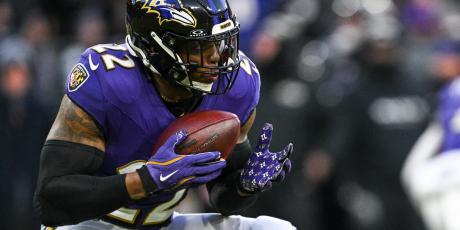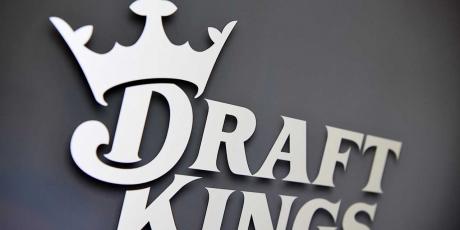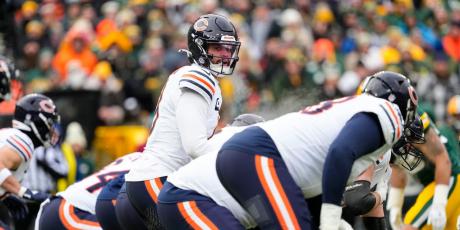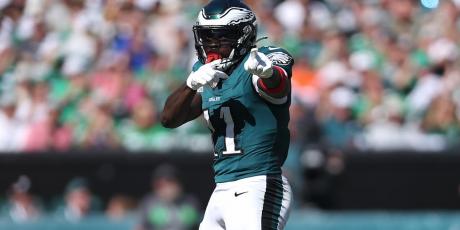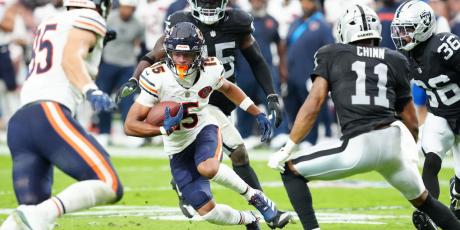Understanding NFL Next Gen Stats
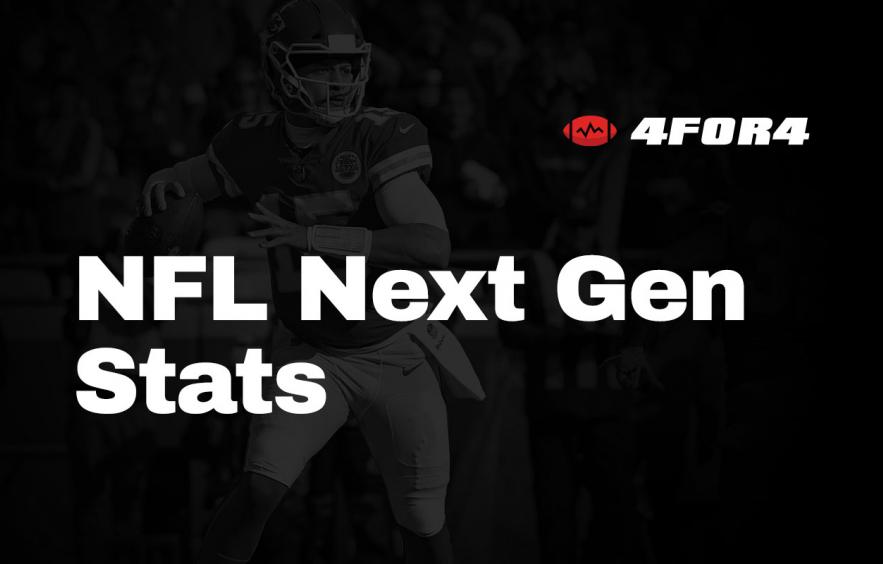
If you watch enough NFL, you’ve seen Next Gen Stats charts or graphics overlaid on your TV screen. Next Gen Stats are fascinating and might be valuable for talent evaluation, but that doesn’t necessarily translate to being useful for fantasy purposes. In this fake football game, we want stats that are predictive, rather than descriptive, and data that translate to fantasy points.
This study will explore the year-to-year correlations and the correlation to fantasy points for every Next Gen Stat and discuss the most relevant categories.
You can find a full list of Next Gen Stats and definitions here.
Next Gen Passing Stats
| Next Gen Stat | Year-to-Year Correlation | Correlation to Fantasy Points |
|---|---|---|
| Time to Throw | 0.62 | 0.17 |
| Average Intended Air Yards | 0.44 | 0.12 |
| Aggressiveness | 0.35 | -0.13 |
| Expected Completion Percentage | 0.35 | 0.07 |
| Average Completed Air Yards | 0.35 | 0.21 |
| Average Yards to Sticks | 0.33 | 0.18 |
| Average Yards Differential | 0.31 | 0.12 |
| Completion Percentage Above Expectation | 0.31 | 0.43 |
| Longest Completed Air Distance | 0.16 | 0.41 |
Time to Throw
Of the Next Gen Passing Stats, Time to Throw (TT) is the most predictable from one year to the next. The stat itself is self-explanatory—Time to Throw measures the average amount of time elapsed from the time of snap to throw on every pass attempt for a passer (sacks excluded).
While TT does not have a strong direct relationship with fantasy points scored, there are some indirect fantasy implications. Consider the players with the highest and lowest average TT over the four years of Next Gen data.
| Player | 2016 | 2017 | 2018 | 2019 | Average TT |
|---|---|---|---|---|---|
| Tyrod Taylor | 3.13 | 3.02 | 3.08 | ||
| Josh Allen | 3.22 | 2.85 | 3.04 | ||
| Lamar Jackson | 3.10 | 2.92 | 3.01 | ||
| Deshaun Watson | 3.10 | 3.01 | 2.82 | 2.98 | |
| Sam Darnold | 2.91 | 2.92 | 2.92 |
| Player | 2016 | 2017 | 2018 | 2019 | Average TT |
|---|---|---|---|---|---|
| Drew Brees | 2.42 | 2.58 | 2.59 | 2.57 | 2.54 |
| Ben Roethlisberger | 2.59 | 2.56 | 2.55 | 2.57 | |
| Derek Carr | 2.49 | 2.49 | 2.55 | 2.82 | 2.59 |
| Ryan Fitzpatrick | 2.45 | 2.66 | 2.65 | 2.61 | 2.59 |
| Philip Rivers | 2.65 | 2.61 | 2.62 | 2.63 | 2.63 |
Unsurprisingly, the passers with the highest average TT are mobile passers but also quarterbacks who take a lot of sacks. Tyrod Taylor and Deshaun Watson have two of the three highest sack rates since 2016 (45 qualified quarterbacks) and Josh Allen has the 11th-highest sack rate in that span. On the flip side, 38 quarterbacks have higher sack rates than Philip Rivers, Derek Carr, Drew Brees and Ben Roethlisberger over the last four years. You’re not going to shy away from using the mobile passers in fantasy, but they could be sneaky targets when searching for a defense to stream or use in DFS.
Average Intended Air Yards
Some fantasy footballers use this name interchangeably with average depth of target. NFL defines Average Intended Air Yards (IAY) as “the average Air Yards a passer throws on all attempts. This metric shows how far the ball is being thrown ‘downfield’.”
Consider the players with the highest IAY in Next Gen history.
| PLAYER NAME | 2016 | 2017 | 2018 | 2019 | AVG |
|---|---|---|---|---|---|
| Jameis Winston | 10.7 | 10.5 | 10.8 | 10.5 | 10.6 |
| Josh Allen | 11.0 | 9.4 | 10.2 | ||
| Deshaun Watson | 11.2 | 8.8 | 8.7 | 9.6 | |
| Ryan Fitzpatrick | 9.8 | 8.9 | 10.2 | 9.0 | 9.5 |
| Russell Wilson | 9.2 | 9.8 | 9.2 | 9.4 | 9.4 |
You should notice that there is some overlap between IAY and TT, especially at the top. Allen and Watson rank high on both lists while Russell Wilson just missed the top five in TT—Taylor and Sam Darnold are just outside the top five in IAY. Although TT might lead to some sacks, those quarterbacks are willing to take the time to let deep shots develop and we know that deep throws are among the most valuable in fantasy.
Completion Percentage Above Expectation
No Next Gen Stat correlates to fantasy points as much as Completion Percentage Above Expectation (+/-) but the relationship isn’t so strong that it should serve as a linchpin to fantasy research. A passer’s +/- is their actual completion percentage compared to their Expected Completion Percentage AKA an efficiency metric. In terms of fantasy scoring for quarterbacks, efficiency should be favored over volume but with little year-to-year correlation, this data point is more explanatory than predictive.
Next Gen Rushing Stats
| Next Gen Stat | Year-to-Year Correlation | Correlation to Fantasy Points |
|---|---|---|
| Avg Time Behind Line Of Scrimmage | 0.49 | 0.00 |
| 8+ Defenders in the Box | 0.34 | 0.13 |
| Efficiency | 0.33 | -0.38 |
Efficiency
For this section, I only compared fantasy points generated from rushes to the Next Gen Stats. Except for year-to-year Average Time Behind Line Of Scrimmage (TLOS), there isn’t much correlation here and Efficiency is the only metric with a moderate relationship to fantasy scoring. The negative correlation is intuitive once you understand what the metric means.
“Rushing efficiency is calculated by taking the total distance a player traveled on rushing plays as a ball carrier according to Next Gen Stats (measured in yards) per rushing yards gained. The lower the number, the more of a North/South runner.”
Backs who don’t dance to try to create extra yards tend to create more fantasy points on the ground—the correlation between Efficiency and yards per carry is -0.75, a very strong relationship. The low year-to-year correlation, however, reminds us that like other efficiency metrics, this is a highly unpredictable number.
Next Gen Receiving Stats
| Next Gen Stat | Year-to-Year Correlation | Correlation to Fantasy Points |
|---|---|---|
| Average Targeted Air Yards | 0.79 | 0.12 |
| % Share of Team's Air Yards | 0.61 | 0.76 |
| Average Cushion | 0.54 | -0.17 |
| Expected Yards After Catch | 0.51 | 0.04 |
| Average Separation | 0.51 | -0.15 |
| Yards After Catch | 0.42 | 0.10 |
| YAC Above Expectation | 0.12 | 0.12 |
Average Targeted Air Yards and % Share of Team's Air Yards (TAY%)
For the avid fantasy football player, it’s no secret that Air Yards should be factored into any projection model. As shown here, Average Targeted Air Yards (TAY) is an insanely stable stat, and the bigger a player’s % Share of Team's Air Yards (TAY%), the more fantasy points that player will produce. As we’ve shown before here at 4for4, a player’s TAY is more predictive than popular metrics such as yards after catch, catch rate and even yards per target.
This builds on the fantasy adage that we should be seeking volume with our pass-catchers. A proper addendum would be we should seek down-field volume with our pass-catchers. As far as Next Gen Stats go, Targeted Air Yards are the gold standard for stability and predictable fantasy production.
Here is a list of the highest TAY in Next Gen history among active players and the highest TAY% from 2019:
| Player | 2016 | 2017 | 2018 | 2019 | Average TAY |
|---|---|---|---|---|---|
| DeSean Jackson | 16.0 | 15.8 | 19.1 | 17.0 | |
| Mike Williams | 15.2 | 17.4 | 16.3 | ||
| James Washington | 15.6 | 15.6 | |||
| Breshad Perriman | 14.9 | 16.1 | 15.5 | ||
| Robby Anderson | 17.0 | 12.8 | 16.5 | 15.3 | 15.4 |
| John Brown | 14.8 | 15.7 | 16.3 | 14.2 | 15.3 |
| Mike Evans | 15.5 | 14.2 | 15.7 | 15.3 | 15.2 |
| Will Fuller | 16.3 | 15.6 | 14.6 | 14.0 | 15.1 |
| Marquez Valdes-Scantling | 12.6 | 16.6 | 14.6 | ||
| Marvin Jones | 14.7 | 15.3 | 15.2 | 13.2 | 14.6 |
| Darius Slayton | 14.5 | 14.5 | |||
| John Ross | 14.0 | 14.9 | 14.5 | ||
| Preston Williams | 14.3 | 14.3 | |||
| Kenny Golladay | 14.8 | 12.6 | 15.4 | 14.3 | |
| Kenny Stills | 15.3 | 14.6 | 16.4 | 10.7 | 14.3 |
| Player | TAY% |
|---|---|
| Courtland Sutton | 42.9 |
| Michael Thomas | 41.3 |
| Stefon Diggs | 41.3 |
| Allen Robinson | 39.2 |
| Odell Beckham | 39.0 |
| Terry McLaurin | 37.1 |
| Robby Anderson | 36.7 |
| John Brown | 36.1 |
| Julio Jones | 35.9 |
| DeAndre Hopkins | 34.4 |
| Kenny Golladay | 33.7 |
| D.J. Chark | 33.1 |
| DeVante Parker | 33.1 |
| James Washington | 33.0 |
| Mike Williams | 31.8 |
The Bottom Line
- Next Gen Stats may be useful for talent evaluation but for fantasy purposes, many are more explanatory than predictive and few show a strong correlation to fantasy points.
- For quarterbacks, Time to Throw is a stable metric that can pinpoint passers who take a lot of sacks but are also capable of big plays and, in turn, spike games. The volatility of these passers can make them sneaky targets for fantasy defenses.
- Volume and game script remain king for running backs. Efficiency metrics are unstable.
- Pass-catchers with high Air Yards thrive in fantasy. Use this Next Gen Stat as a cornerstone of research, for both fantasy drafts and weekly decisions

